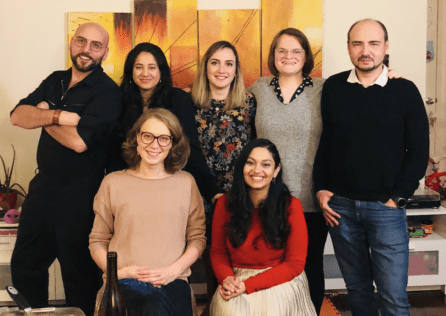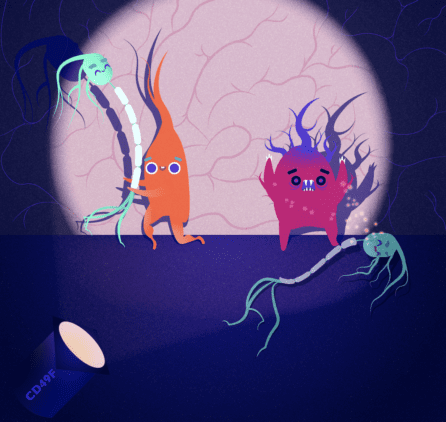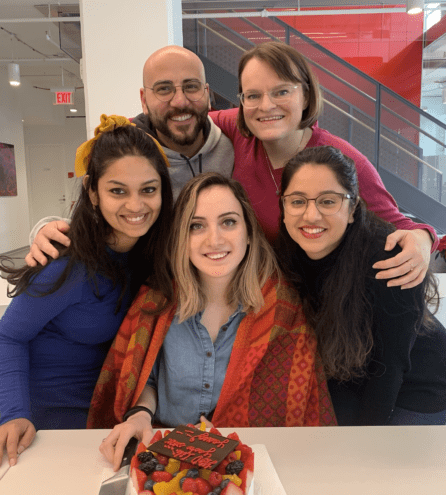Meet Lili Barbar: From Intern to Full Time Researcher to MD/PhD Student
NewsAt Lili Barbar’s final lab meeting (which per a discussion with her team, was pajama-themed), her mentor Valentina Fossati, PhD, began by expressing how much Lili has meant to NYSCF over the past two years.
“I could spend all day talking about Lili and how wonderful she is,” remarked Dr. Fossati. “She has really made the impossible possible in terms of what she has accomplished for our lab. She is a wonderful human being and an excellent scientist.”
“You’re going to make me cry, Valentina!” replied Lili, wiping away a tear with the sleeve of her pajamas as she set up for her presentation. “This group has really been like a family to me.”
Lili joined NYSCF as an intern in the summer of 2017, and later returned as a full-time researcher on Dr. Fossati’s multiple sclerosis (MS) team after graduation. Next month, she will start school at Washington University in St. Louis to receive her MD/PhD.
“Lili is one of many talented young scientists we’ve been privileged to have with us for the beginning of their careers,” said Dr. Fossati. “I’m sure she is a rising star, and I very much look forward to seeing her many successes.”
Intern Beginnings
Lili’s first experience with research was as an undergrad in the lab of NYSCF – Robertson Stem Cell Investigator Alumnus Paul Tesar, DPhil, at Case Western Reserve University. As part of this group, she worked on understanding diseases that affect myelin – the ‘insulation’ around neurons that help them send signals – such as multiple sclerosis and Pelizaeus-Merzbacher disease (for which the team recently found a new treatment possibility).
“When I was looking for summer research opportunities, Paul suggested I apply to NYSCF’s internship program,” Lili explained. “I really liked NYSCF’s work, especially how it used human models to study disease, so it seemed like a perfect fit.”

Lili then spent 10 weeks at The NYSCF Research Institute as a part of the 2017 summer internship program, where she worked with Dr. Fossati to better understand the underpinnings of MS.
“My projects were aimed at examining what happens in the brains of MS patients and determining whether the defects we see in their brain cells are the root of the disease or a result of something else. To study this, I helped generate and analyze neurons created from the stem cells of MS patients.”
She cites NYSCF’s collaborative environment as a major asset for learning about new and complicated aspects of science.
“I got to meet a lot of different people and everyone was so welcoming,” she said. “They were also incredibly knowledgeable and always willing to talk about their work. I learned a lot about fields that I may never have looked into otherwise”
Lili returned to finish her senior year at Case Western in fall 2017 certain that she wanted to pursue science.
“I always knew I loved research, but when I came here and I saw what the different groups were doing and the different routes you can take in the stem cell field, it really solidified my decision to become a scientist.”
Returning after Graduation
After finishing her biology degree in spring 2018, Lili was ready to jump back into the world of research and was welcomed back into Dr. Fossati’s lab for a full-time position.
“One of the main reasons that I came back after my summer internship was so that I could work with Valentina and the other NYSCF scientists again,” noted Lili. “NYSCF has such a supportive environment and I knew I could continue to learn a lot there.”

Lili’s primary project as a full-time researcher involved astrocytes – star-shaped support cells in the brain – and their role in neurodegenerative diseases such as multiple sclerosis, Alzheimer’s, and Parkinson’s. Dr. Fossati’s team was interested in seeing whether these normally helpful cells may become toxic to the neurons they support when in disease-like environments, which had been previously observed in mice by their collaborator, Shane Liddelow, PhD, of NYU. Lili helped develop a method for turning human stem cells into astrocytes and discovered that the ‘rogue astrocyte’ phenomenon did, in fact, continue to happen in inflammatory, disease-like environments.
“This was an exciting result because it showed for the first time in human cells that inflammation can drive neurodegeneration,” said Lili, who is first author on the study, recently published in Neuron. “This opens the door for new treatments that target this mechanism, and it is a very promising new avenue for research.”
To learn more about how inflammation plays a role in neurodegenerative diseases, join an interactive webinar on July 30th at 4:30 EST. Register here.
Lili worked closely with a researcher in Dr. Liddelow’s lab named Indigo Rose who is also heading off to graduate school this fall. Dr. Liddelow reflected that along with the intriguing results, one of the most rewarding aspects of the project was working with talented young minds like Indigo and Lili.
“They are just absolute powerhouses, and did an amazing job driving this project,” he remarked. “Seeing them move on to bigger and better things is just fantastic.”
Looking Forward
“Since growing up, I’ve wanted to pursue an MD/PhD because I love research, but I also want to directly see and treat patients,” explained Lili.
MD/PhD programs typically span 8 years in which students conduct research while also earning a medical degree. Lili begins her MD/PhD program at Washington University (which houses the largest medical scientist program in the country) in just a few weeks.

Lili credits her time at NYSCF for preparing her for the future and reminding her why she loves science.
“We do translational science using human cells, which has the potential to make a big impact in the clinic,” she remarked. “In my time at NYSCF, I learned how to conduct good research and ask the right questions. And with NYSCF’s outreach and education efforts, I was able to meet and hear from a lot of patients, and it always reminded me of why I was doing what I was doing.”
While Lili will miss her NYSCF family, she knows this isn’t goodbye forever.
“Even though I’m leaving, I will keep in touch with everyone and I’m positive we will remain close. I’m sure NYSCF will continue to do great things, and I can’t wait to see them.”

